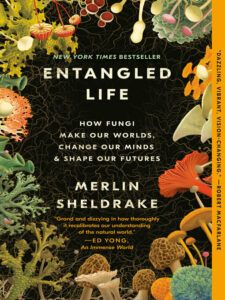I’ve read several books lately that focus on the tiniest forms of life—some creatures charming and inspiring, others, devastatingly harmful, and still others, playing both of those roles at once:
The Comfort of Crows: A Backyard Year by Margaret Renkl (2023)
 The Comfort of Crows is a beguiling account of Renkl’s messy, native-plant-filled yard, one her neighbors complain about but that she stubbornly refuses to change in order to help the creatures her lawn refuse feeds and houses. Renkl covers an entire year of activity of the beetles, butterflies, birds and other small beings her native garden harbors as they go about their non-human business–which Renkl conveys with poetic detail. The author is not shy about noting the devastating effects of climate change on her animal friends, nor does she hesitate to share the burden of guilt she herself feels for lifestyle choices that may add to our carbon footprint. Yet, aside from a moment or two of finger-wagging toward her complaining neighbors, The Comfort of Crows is sheer descriptive delight.
The Comfort of Crows is a beguiling account of Renkl’s messy, native-plant-filled yard, one her neighbors complain about but that she stubbornly refuses to change in order to help the creatures her lawn refuse feeds and houses. Renkl covers an entire year of activity of the beetles, butterflies, birds and other small beings her native garden harbors as they go about their non-human business–which Renkl conveys with poetic detail. The author is not shy about noting the devastating effects of climate change on her animal friends, nor does she hesitate to share the burden of guilt she herself feels for lifestyle choices that may add to our carbon footprint. Yet, aside from a moment or two of finger-wagging toward her complaining neighbors, The Comfort of Crows is sheer descriptive delight.
Entangled Life: How Fungi Make Our Worlds, Change Our Minds & Shape Our Futures by Merlin Sheldrake (2020)
 You will never pop a mushroom into your mouth again without marveling at its nature after reading Merlin Sheldrake’s Entangled Life. Sheldrake reveals all the details of the fascinating world of fungi, a life form which she insists is the backbone of our planetary existence. Without fungi, she tells us, our own cells couldn’t function adequately—and neither could the plants we rely on for food as well as the oxygen we breathe. Fungi live everywhere, in the most unexpected places, and perform the most startling feats, such as finding the quickest route through a maze or glowing in the dark. Whether wrapping themselves around the roots of plants or sprouting, zombie-like, out of the body of an ant, the “Fungus AmoungUs” will astound you in ways you’ve never dreamed of.
You will never pop a mushroom into your mouth again without marveling at its nature after reading Merlin Sheldrake’s Entangled Life. Sheldrake reveals all the details of the fascinating world of fungi, a life form which she insists is the backbone of our planetary existence. Without fungi, she tells us, our own cells couldn’t function adequately—and neither could the plants we rely on for food as well as the oxygen we breathe. Fungi live everywhere, in the most unexpected places, and perform the most startling feats, such as finding the quickest route through a maze or glowing in the dark. Whether wrapping themselves around the roots of plants or sprouting, zombie-like, out of the body of an ant, the “Fungus AmoungUs” will astound you in ways you’ve never dreamed of.
The Sound of a Wild Snail Eating by Elisabeth Tova Bailey (2016)
 Equaling the charm factor of The Comfort of Crows is Elisabeth Tova Bailey’s The Sound of a Wild Snail Eating. When Bailey was a young woman, she contracted a debilitating illness that kept her bedridden for a full year. One of her visiting friends noticed a large snail outside Bailey’s residence as well as a clump of blooming violets and a clay pot. She potted the violets and placed the snail under the leaves. And so, for the next year of Bailey’s illness, she entertained herself by documenting the life of her new companion, a land snail. Peppering her account of the surprisingly agile antics of her mollusk friend with facts gleaned from research on the curious lives of such creatures, Bailey also uses the snail as a metaphor for the life of the bed-bound, giving us insight into the emotions that accompany being limited by illness or injury.
Equaling the charm factor of The Comfort of Crows is Elisabeth Tova Bailey’s The Sound of a Wild Snail Eating. When Bailey was a young woman, she contracted a debilitating illness that kept her bedridden for a full year. One of her visiting friends noticed a large snail outside Bailey’s residence as well as a clump of blooming violets and a clay pot. She potted the violets and placed the snail under the leaves. And so, for the next year of Bailey’s illness, she entertained herself by documenting the life of her new companion, a land snail. Peppering her account of the surprisingly agile antics of her mollusk friend with facts gleaned from research on the curious lives of such creatures, Bailey also uses the snail as a metaphor for the life of the bed-bound, giving us insight into the emotions that accompany being limited by illness or injury.
